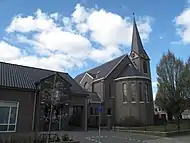Loosbroek
Loosbroek is a village and parish in the southern Netherlands. It is located in the municipality Bernheze, North Brabant.[1] Loosbroek has about 1266 (2011) inhabitants.
Loosbroek | |
|---|---|
| Coordinates: 51°41′0″N 5°30′0″E | |
| Country | Netherlands |
| Province | North Brabant |
| Municipality | Bernheze |
| Population (1 January 2011) | 1,266 |
| Major roads | A50, N279, N606 |
Before 1994 the territory of Loosbroek was divided between three municipalities, Nistelrode, Heesch and Heeswijk-Dinther.
History

In 1648, after the Protestant Reformation, Loosbroek became part of the States of Brabant with the "Meierij van 's-Hertogenbosch". In 1795 the French invaded the Dutch Republic and "freedom of faith" was restored in Loosbroek. In 1814 Loosbroek became part of the Kingdom of the Netherlands.
On 23 September 1923, two American officers and participants in the Gordon Bennett Cup crashed near Loosbroek when lightning struck their gas balloon. They had departed form Brussels. The gas balloon race was a disaster for three balloons were struck by lightning. Five people died and one person was severely injured.[2][3]
Until 1898 Loosbroek was part of the parish of Dinther. In that year the village was allowed to start their own parish.
Attractions
- The Saint-Antoniuskerk opened in 1913. The neo-romantic design is by Jos Margry; The priest at that time was Albertus Werners. In 2005 the church was restored. Outside the church is a painted stone statue of the Saint Donatus of Muenstereifel.
- The Bleeken is a nature resort to the North-West of Loosbroek. The area is known for its badgers.
- To the west of Loosbroek is a fresh water reservoir of 30 acres. The area is free accessible.
Towns nearby
References
- "Gemeente Bernheze" (in Dutch). Gemeente Bernheze. Retrieved 5 March 2011.
- "Luchtballon op Loosbroek" (in Dutch). Brabants Historisch Informatie Centrum. Retrieved 3 March 2011.
- "Scores of Lives Deliberately Risked and Sacrificed in Pursuit of Knowledge to Protect Others From Disease and Death". Popular Mechanics. Popular Mechanics Co. 44 (July): 49–54. 1925.
External links